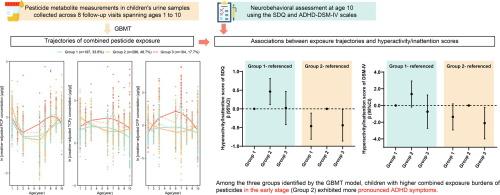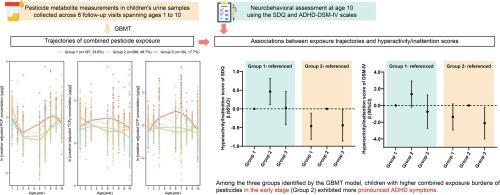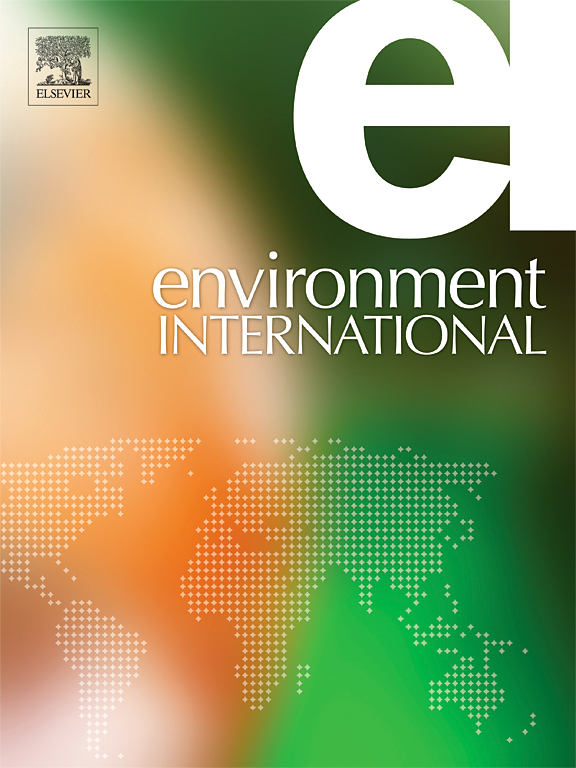识别与 10 岁时行为问题相关的儿童农药暴露轨迹和关键窗口:来自 SMBCS 的研究结果
IF 9.7
1区 环境科学与生态学
Q1 ENVIRONMENTAL SCIENCES
引用次数: 0
摘要
背景农药可能会影响儿童的神经发育。由于儿童的新陈代谢功能和神经可塑性在其生长发育过程中会发生变化,因此农药暴露的影响也可能有所不同。方法我们对一项队列研究中收集的 1、2、3、6、7、8、9 和 10 岁儿童尿样中的三种农药代谢物 [五氯苯酚 (PCP)、3,5,6-三氯-2-吡啶醇 (TCPy) 和呋喃丹酚 (CFP)]进行了重复测量。研究分别采用了基于群体的多轨迹模型(GBMT)和潜类分析(LCA)来描述儿童期农药混合物暴露的不同轨迹和模式。同时,采用《精神疾病诊断与统计手册》第四版(DSM-IV)中的优势与困难问卷(SDQ)和注意缺陷多动障碍(ADHD)标准来评估儿童的行为障碍。结果 GBMT 模型划定了儿童综合农药暴露的三种不同轨迹:持续低水平、幼儿期较高水平向学龄前较低水平过渡,以及幼儿期较低水平向幼儿中期较高水平过渡。生命周期分析模型确定了三种类似的纵向接触模式。此外,与其他两组相比,GBMT 确定的第二组轨迹中的儿童表现出显著的多动/注意力不集中得分(β = 0.46, 95 %CI: 0.结论我们的研究表明,儿童早期(尤其是两岁之前)而非其他年龄段接触杀虫剂与 10 岁儿童的多动/注意力问题有关。我们还提供了一个新的视角来描述重复测量多种环境化学物质的波动,并确定潜在的关键窗口。本文章由计算机程序翻译,如有差异,请以英文原文为准。


Identifying childhood pesticide exposure trajectories and critical window associated with behavioral problems at 10 years of age: Findings from SMBCS
Background
Pesticides may impact children’s neurodevelopment. As children’s metabolic function and neural plasticity change throughout their growth and development, the effects of pesticide exposure may also vary.
Objectives
We aimed to identify the trajectories of combined pesticide exposure during childhood, and to examine the associations of the exposure trajectories with children’s neurobehavior at the age of 10.
Methods
We involved repeated measurements of three pesticide metabolites [Pentachlorophenol (PCP), 3,5,6-Trichloro-2-pyridinol (TCPy), and Carbofuran phenol (CFP)], in urine samples collected from children in a cohort study at ages 1, 2, 3, 6, 7, 8, 9, and 10 years. The group-based multi-trajectory model (GBMT) and latent class analysis (LCA) were separately utilized to describe the distinct trajectories and patterns of pesticide mixture exposure during childhood. Meanwhile, the Strengths and Difficulties Questionnaire (SDQ) and attention deficit hyperactivity disorder (ADHD) Criteria of Diagnostic and Statistical Manual of Mental Disorders, Fourth Edition (DSM-IV) list were applied to assess behavioral disorders in children. The associations between exposure trajectories and behavioral problem scores were then examined.
Results
The GBMT model delineated three distinct trajectories of combined pesticide exposure among children: consistently low, higher levels in early childhood transitioning to lower levels during pre-school age, and lower levels in early childhood followed by higher levels in the middle childhood. The LCA model identified three similar longitudinal exposure patterns. Further, the children in the second trajectory group identified by GBMT, characterized by higher early childhood exposure levels, exhibited significantly elevated hyperactivity/inattention scores of the SDQ compared to the other two groups (β = 0.46, 95 %CI: 0.11, 0.81; β = 0.44, 95 %CI: 0.02, 0.86).
Conclusions
Our study revealed that exposure to pesticides during early childhood (especially before the age of two), rather than other age periods, was linked to hyperactivity/inattention problems in children aged 10 years. We also provided a novel perspective on characterizing the fluctuation in repeated measurements of multiple environmental chemicals and identifying the potential critical windows.
求助全文
通过发布文献求助,成功后即可免费获取论文全文。
去求助
来源期刊

Environment International
环境科学-环境科学
CiteScore
21.90
自引率
3.40%
发文量
734
审稿时长
2.8 months
期刊介绍:
Environmental Health publishes manuscripts focusing on critical aspects of environmental and occupational medicine, including studies in toxicology and epidemiology, to illuminate the human health implications of exposure to environmental hazards. The journal adopts an open-access model and practices open peer review.
It caters to scientists and practitioners across all environmental science domains, directly or indirectly impacting human health and well-being. With a commitment to enhancing the prevention of environmentally-related health risks, Environmental Health serves as a public health journal for the community and scientists engaged in matters of public health significance concerning the environment.
 求助内容:
求助内容: 应助结果提醒方式:
应助结果提醒方式:


